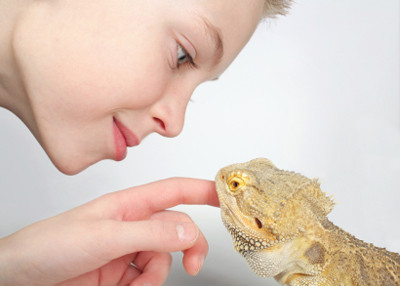
We’re pleased to present the latest installment of Dr. Rick Hanson’s Greater Good blog, featuring posts from his Just One Thing (JOT) newsletter, which offers simple practices designed to bring you more joy, more fulfilling relationships, and more peace of mind and heart.
I’ve recently had a melanoma pulled out of my ear. Happily, it was entirely localized and I’m fine, now recuperating with a very tender sewn-up ear. But working through my own little health drama gave me a new appreciation for life—and made me particularly aware of that little primal, scared place inside us all.
This part of us first evolved hundreds of millions of years ago, and it needs a lot of tender care to settle down and be less anxious.
Thus this post’s practice, with an admittedly odd title: Pet the lizard.
Why?
I’ve always liked lizards.
 © Nathan Allred
© Nathan Allred
Growing up on the outskirts of Los Angeles, I played in the foothills near our home. Sometimes I’d catch a lizard and stroke its belly so it would relax in my hands, seeming to feel at ease.
In my early 20s, I found a lizard one chilly morning in the mountains. It was torpid and still in the cold and let me pick it up. Concerned that it might be freezing to death, I placed it on the shoulder of my turtleneck, where it clung and occasionally moved about for the rest of the day. There was a kind of wordless communication between us, in which the lizard seemed to feel I wouldn’t hurt it, and I felt it wouldn’t scratch or bite me. After a few hours, I hardly knew it was there, and sometime in the afternoon it left without me realizing it.
Now, years later, as I’ve learned more about how the brain evolved, my odd affinity for lizards has started making sense to me. To simplify a complex journey beginning about 600 million years ago, your brain has developed in three basic stages:
- Reptile - Brainstem, focused on avoiding harm
- Mammal - Limbic system, focused on approaching rewards
- Primate - Cortex, focused on attaching to “us”
Of course, the brain is highly integrated, so these three key functions—avoiding, approaching, and attaching—are accomplished by all parts of the brain working together. Nonetheless, each function is particularly served by the region of the brain that first evolved to handle it. This fact has significant implications.
For example, in terms of avoiding harm, the brainstem and the structures just on top of it are fast and relatively rigid. Neuroplasticity—the capacity of the brain to learn from experience by changing its structure—increases as you move up both the evolutionary ladder and the layered structures of the brain.
Consequently, if you want to help yourself feel less concerned, uneasy, nervous, anxious, or traumatized—feelings and reactions that are highly affected by “reptilian,” brainstem-related processes—then you need many, many repetitions of feeling safe, protected, and at ease to leave lasting traces in the brainstem and limbic system structures, which produce the first emotion, the most primal one of all: fear.
Or to put it a little differently, your inner iguana needs a lot of petting!
How?
To begin with, I’ve found it helps me to appreciate how scared that little lizard inside us is. Lizards—and early mammals, emerging about 200 million years ago—that were not always vigilant would fail the first test of life in the wild: eat lunch—but don’t be someone else’s lunch.
So be aware of the ongoing background trickle of anxiety in your mind, the subtle guarding and bracing with people and events as you move through your day. Then, again and again, try to relax by reminding yourself that you are actually alright right now, and send soothing and calming down into the most ancient layers of your mind.
Also soothe your own body. Most of the signals coming into the brain originate inside the body, not from out there in the world. Therefore, as your body settles down, that sends feedback up into your brain that all is well—or at least not too bad.
Take a deep breath and feel each part of it, noticing that you are basically OK, and letting go of tension and anxiety as you exhale; repeat as you like.
Shift your posture—even right now as you read this—to a more comfortable position. As you do activities such as eating, walking, using the bathroom, or going to bed, keep bringing awareness to the fact that you are safe, that necessary things are getting done just fine, that you are alive and well.
Throughout, keep taking in the good of these many moments of petting your inner lizard. Register the experience in your body of a softening, calming, and opening; savor it; stay with it for 10-20-30 seconds in a row so that it can transfer to implicit memory. (For more on how to “take in the good” and defeat the innate negativity bias of the brain—whose unfortunate default setting is to be Velcro for negative experiences but Teflon for positive ones—read this Greater Good essay of mine, and consider attending this GGSC seminar—live or online—that I’ll be leading on October 15.)
Some have likened the mind/brain to a kind of committee. Frankly, I think it’s more like a jungle! We can’t get rid of the critters in there—they’re hardwired into the brain—but we can tame and guide them. Then, as the bumper sticker says, they wag more and bark less.
Or relax, like a lizard at ease in the sun.








Comments
Great advice! It reminds me too of the benefits of meditation and chanting. I take a special interest in therapsids and early mammals - if you like lizard-ish animals, get a cat. They have few genes and have not evolved as much as dogs. Didn’t Dr. Keltner at some point mention the vagus nerve in non-human animals? I think that even amphibians have that nerve, although it’s not called the vagus. I think it’s the pneumo-gastric nerve (maybe). In any case - I know that avian neuroscience is being completely overhauled to compensate for new brain findings. It seems like the science is advancing at amazing speeds. Have you read the articles on Pat Shipman’s new hypothesis? It’s quite fascinating.
http://articles.boston.com/2010-09-12/news/29285010_1_animals-cat-pets
Emmy | 12:16 pm, July 20, 2011 | Link
For people like me who are curious about the genesis
of things, this story helps me understand why I often
feel an undercurrent of anxiety. Knowing that it is
human nature to feel the presence of a subtle but
almost constant flow of anxiety run through my veins
is reassuring. With this insight, I can be aware of it,
pause, breathe through it for a few moments and self
soothe. I get it. Thanks.
Lisa Jacobson | 5:09 am, July 29, 2011 | Link
I find the article thought provoking and soothing at
the same time - except for one line: most of the
signals coming into the brain originate inside us not
outside us. This may be true for the moment, but
cumulative experience, which intimately activates,
and makes up brain, body, feeling, and being
stimuli has everything to do with the external
world. If someone from infancy on always felt safe
and loved, it is unlikely the lizard part would
dominate. In a world that insists on each ‘earning’ a
living, ie: earning life, it can be expected that we
are pretty much caught in lizard brain, even if one
is extremely wealthy ... at which point lizard brain
is probably in overdrive to protect the wealth at all
cost. I think what makes the central difference
between avoid, approach and attach is the world
around us… Where may I ask has any person the
right - in this having to earn life world - to just rest
and recover on a warm shoulder…without having
to pay for it in one way or another?
Lise Cyrinne | 12:13 am, July 30, 2011 | Link
I disagree with both Lise and Rick.
When Rick says that most of the signals coming into the brain are from the body, he may be right in the sense of hard wiring; i.e. the nervous system. But this position greatly diminishes the importance of our mind’s internal chatter on our emotions.
Similarly, Lise makes a very valid point about the external source of much of our anxiety, and her socio-political implication is not lost on me. But here again, what we think about our situation in the world is central to our emotional reaction thereto.
Rick’s prescription strikes me as a simple form of meditation exercise, not a million miles away from basic breathing and awareness exercises. And that’s fine - up to a point. There is only so much you’re going to be able to achieve by calming your inner lizard in this way. The real challenge we face as thinking apes is how to calm those pesky, ethereal thoughts. And for that, we need to take our meditations to a more sophisticated level than this.
P.S. Emmy - I enjoyed your link, but what is this business about cats being less evolved than dogs?
Higher Plane | 6:45 pm, August 15, 2011 | Link
@HP Sorry I did not explain better and I do not want to go off topic too much, but cats have fewer genes than dogs. This is probably because nature hit upon the perfect body form early on: an obligate meat eater that needs only to kill in order to survive. Cats did not change much over time. This is why cats mostly look the same whereas dog forms vary wildly. Read “Your Cat” by Hodgkins and the article called Why is Aspirin Toxic to Cats on the Not Exactly Rocket Science blog for more. 😊
Emmy | 6:14 am, August 16, 2011 | Link
Emmy - Thanks for another good link (and a nice personal blog, too). Bookmarked both. Cheers.
The sidebar discussion of cats, while seemingly off-topic, could in fact give Rick another article. If the mammalian vestiges in our brain are interested in “approaching rewards” (which our dog displays with excessive clarity - though that leads to another tangent on wolf evolution) then what do we need to do to calm our “inner mammal”? Give ourselves regular treats? Make sure we get chocolate or ice cream every day? Are people with eating disorders dominated by an inner wolf worried about when it will see food again?
We seem to be in danger of creating a new pseudo-science to rival astrology - a human psychological taxonomy based on evolutionary ancestors. Of course, the Bible-bashers won’t be able to join in the fun. Ironic, really, given that their inner primate is being satisfied by the feeling of belonging to a congregation….
Higher Plane | 8:35 am, August 16, 2011 | Link
Sorry but if we could return to Higher Plane’s
earlier point about how to truly stop anxiety. I
think that a meditation exercises can calm anxiety
because when people successfully meditate they
ruminate less which calms those “pesky, ethereal
thoughts” less rumination should therefore lead to
less anxiety if the anxiety caused by conscious
thought. If anxiety is caused by conscious thought
the lizard analogy fails because lizards probably
aren’t smart enough to ruminate. The authors
point seems to be that anxiety is caused not
through our conscious thought but through the way
our brain is hardwired to work. Either way
meditative exercises could help erase this natural
fear.
My only problem with the authors point is similar to
Lise’s idea that past events have been proven to
change a person’s levels of anxiety especially in
relation to their partners. So although anxiety may
be due to natural instinct anxiety may also be a
way of the brain trying to learn from past trauma
(people with parents who divorced are more likely
to be anxiously attached to their partners.)
All in all I think this article, whether or not the
lizard analogy holds, still offers good advice to
avoid anxiety.
Harry Cooke | 6:55 pm, August 19, 2011 | Link
that’s discusting
Asala mp3 | 11:45 am, November 11, 2011 | Link
great article will always attract lot of attention of
bloggers and visitor t grab the content. Thanks
aku | 7:42 pm, January 3, 2012 | Link